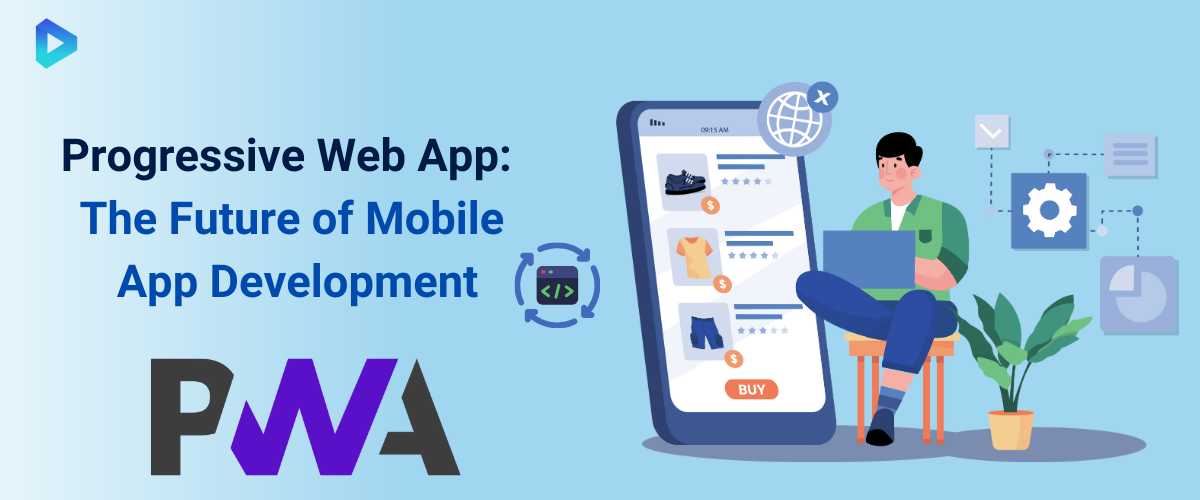
Why Progressive Web Apps Are The Future Of Mobile App Scalability

Progressive Web Apps (PWAs) are revolutionizing the way we interact with mobile applications. Combining the best features of web and native apps, PWAs offer fast loading speeds, offline functionality, and seamless user experiences. As businesses strive to meet the growing demand for mobile-friendly solutions, PWAs are emerging as a cost-effective and efficient alternative to traditional native apps. In this blog, we’ll explore why Progressive Web Apps are the future of mobile development, their key benefits, and how they’re transforming industries worldwide.
Understanding Progressive Web Apps and Their Definition
Progressive Web Apps (PWAs) are redefining the way users interact with the web. Let’s explore what they are and why they matter.
What Is a Progressive Web App (PWA)?
A Progressive Web App (PWA) is a modern web application that combines the best features of websites and mobile apps. Built using standard web technologies like HTML, CSS, and JavaScript, PWAs deliver app-like experiences directly through web browsers. They are fast, reliable, and work seamlessly across devices, even offline. PWAs eliminate the need for app store downloads, making them accessible to everyone. Businesses and developers are adopting PWAs to provide users with a smooth, engaging experience while reducing development costs and time.
Key Characteristics of Progressive Web Apps
PWAs are defined by their unique features, which set them apart from traditional web and mobile apps:
- Responsive Design: Adapts to any screen size, from desktops to smartphones.
- Offline Functionality: Works without an internet connection using service workers.
- App-Like Experience: Feels like a native app with smooth navigation and interactions.
- Push Notifications: Engages users with timely updates and alerts.
- Secure: Served over HTTPS to ensure data safety.
These characteristics make PWAs a powerful tool for businesses and developers aiming to enhance user experiences.
How PWAs Differ from Traditional Web and Mobile Apps?
PWAs bridge the gap between traditional web and mobile apps. Unlike regular websites, PWAs offer offline access and push notifications. Compared to native apps, PWAs don’t require installation from app stores, saving storage space on devices. They are also easier to update since changes are reflected instantly without user intervention. For businesses, PWAs provide a cost-effective solution to reach a wider audience while delivering a native app-like experience. This makes them ideal for startups, small businesses, and enterprises alike.
How Progressive Web Apps Work Offline?
PWAs deliver seamless offline experiences. Let’s explore how they achieve this.
Role of Service Workers in Offline Functionality
Service workers play a crucial role in enabling offline functionality in Progressive Web Apps. They act as a background script that runs separately from the main application, allowing PWAs to manage network requests, cache resources, and provide content even when the user is offline. When a user accesses a PWA, service workers intercept network requests and determine whether to serve cached content or attempt a live connection. This mechanism ensures that essential features, such as browsing previously visited pages or accessing saved data, remain available without an internet connection. Service workers also enable background synchronization and push notifications, further enhancing user experience and engagement.
Storing and Caching Data for Seamless Experience
PWAs leverage caching strategies to provide a smooth offline experience. By storing static assets such as HTML, CSS, and JavaScript files, service workers ensure that users can continue interacting with the app without delays. There are different caching strategies used in PWAs, including:
- Cache First – Loads content from the cache before attempting a network request.
- Network First – Attempts to fetch fresh data from the network before falling back to cached content.
- Stale-While-Revalidate – Serves cached data while simultaneously fetching updated content in the background.
These caching techniques allow businesses to maintain high performance, reduce server load, and keep users engaged even in low or no connectivity environments.
Real-World Examples of Offline-Enabled PWAs
Several leading companies have successfully implemented offline capabilities in their PWAs to improve user experience:
- Twitter Lite – Allows users to browse tweets and media offline using cached data.
- Forbes – Ensures articles remain accessible even when users lose internet connectivity.
- Starbucks – Enables customers to browse menus and customize orders without an active connection.
- Google Maps PWA – Lets users access saved locations and navigate offline.
These examples highlight how offline-enabled PWAs enhance accessibility and reliability, making them a preferred choice for businesses aiming to reach users in all connectivity conditions.
Exploring the Top Features of Progressive Web Apps
Progressive Web Apps (PWAs) are packed with features that redefine user experiences. Let’s dive in.
Fast Load Times and Smooth Performance
Progressive Web Apps (PWAs) are designed to deliver exceptional performance by ensuring fast load times and seamless user interactions. They utilize caching mechanisms, such as service workers, to store essential assets locally, reducing dependence on network speed. This results in faster page rendering and a more responsive experience, even in low-bandwidth conditions. Additionally, PWAs use lazy loading techniques to prioritize loading only necessary content, improving efficiency. By optimizing JavaScript execution and minimizing HTTP requests, PWAs provide a near-instantaneous experience, enhancing user satisfaction and engagement.
Push Notifications for Improved User Engagement
One of the standout features of PWAs is their ability to send push notifications, keeping users informed and engaged even when they are not actively using the app. These notifications help businesses:
- Re-engage users with personalized updates and promotions.
- Provide real-time alerts for transactions, news, or important updates.
- Increase customer retention by encouraging repeated interactions.
Push notifications function similarly to those in native apps, enabling businesses to create customized messages that drive higher engagement rates without requiring users to install a traditional mobile application.
Cross-Platform Compatibility and Responsive Design
PWAs are designed for smooth performance across multiple devices and operating systems. Their responsive design ensures a consistent user experience, whether accessed on a desktop, tablet, or smartphone. Unlike native apps, which require separate development for iOS and Android, PWAs adapt to different screen sizes and orientations automatically. This flexibility allows businesses to reach a broader audience while reducing development costs. The ability to work on multiple devices without compromising functionality makes PWAs a powerful solution for businesses aiming to enhance accessibility and usability.
Key Benefits of Progressive Web Apps for Businesses
Progressive Web Apps (PWAs) offer game-changing advantages for businesses. Let’s explore them.
Cost-Effectiveness Compared to Native Apps
Progressive Web Apps (PWAs) provide a budget-friendly alternative to traditional native apps by reducing development and maintenance costs. Unlike native applications, which require separate versions for iOS and Android, PWAs function across all platforms using a single codebase. This eliminates the need for multiple development teams, resulting in significant cost savings. Additionally, businesses avoid app store fees, as PWAs can be directly accessed through a browser. By reducing development complexity and ongoing maintenance expenses, companies can invest more resources into enhancing user experience and marketing efforts.
Improved SEO and Increased Organic Traffic
PWAs contribute to better search engine visibility, helping businesses attract more organic traffic. Since they are web-based, they are indexed by search engines like Google, unlike native apps, which are limited to app stores. Key SEO benefits of PWAs include:
- Faster page loading times, improving search rankings.
- Mobile-friendliness, ensuring higher visibility on search results.
- Reduced bounce rates due to improved user experience.
By optimizing for SEO, businesses can drive more traffic, enhance customer engagement, and increase conversions without relying solely on paid advertising.
Enhanced Security and Data Protection with HTTPS
Security is a top priority for businesses and users alike. PWAs ensure data protection by requiring HTTPS, which encrypts communication between the user and the server, safeguarding sensitive information. The security benefits of HTTPS include:
- Protection against data breaches and cyberattacks.
- Secure payment processing for e-commerce transactions.
- Trust and credibility with users due to encrypted connections.
By implementing strong security protocols, businesses can build customer trust, prevent unauthorized access, and comply with data protection regulations, ensuring a safer online experience.
The Process of Progressive Web App Development
Building a PWA? Follow this step-by-step guide to begin your journey.
Essential Tools and Technologies for PWA Development
Developing a Progressive Web App (PWA) requires a combination of modern web technologies and frameworks. Key tools and technologies include:
- Service Workers: Enable caching and offline functionality.
- Web App Manifest: Provides metadata for the app’s appearance and behavior.
- React, Angular, or Vue.js: Popular JavaScript frameworks for building dynamic UIs.
- Lighthouse: A Google tool for optimizing PWA performance.
- HTTPS: Ensures security and data integrity.
Using the right technologies ensures that PWAs provide fast, reliable, and engaging experiences across multiple devices.
Best Practices for Building High-Performance PWAs
Creating an efficient PWA requires following best practices that enhance usability, speed, and engagement. These include:
- Optimizing Load Speed: Minimize file sizes and leverage lazy loading.
- Ensuring Offline Accessibility: Implement caching strategies using service workers.
- Enhancing Mobile Responsiveness: Use flexible grids and adaptive UI components.
- Enabling Push Notifications: Improve user retention with timely updates.
Following these practices results in a seamless user experience that rivals native apps.
Common Challenges in PWA Development and Solutions
Despite their advantages, PWAs come with challenges that developers must address:
- Limited Device Access: Some hardware features, like Bluetooth, are restricted.
- SEO Challenges: PWAs rely on JavaScript, which can affect search indexing.
- Browser Compatibility Issues: Ensure cross-browser support for a wider reach.
Progressive Web App vs. Native App: Which is Better?
Choosing between PWAs and native apps? Let’s break down the differences and benefits.
Key Differences Between PWAs and Native Apps
Progressive Web Apps (PWAs) and native apps serve similar purposes but differ in their structure, functionality, and development approach. PWAs are web-based applications that function across multiple devices without requiring installation, while native apps are specifically built for particular operating systems like iOS or Android. The main distinctions between the two are as follows:
- Development and Maintenance: PWAs use a single codebase, whereas native apps require separate development for different platforms.
- Installation: Native apps must be downloaded from an app store, while PWAs run directly from a browser.
- Performance: Native apps offer better performance and access to device hardware, whereas PWAs focus on accessibility and speed.
- Updates: PWAs update automatically, whereas native apps require users to install updates manually.
Choosing between PWAs and native apps depends on the business goals, budget, and target audience preferences.
When to Choose a PWA Over a Native App?
PWAs are an excellent choice for businesses seeking a cost-effective, user-friendly, and easily accessible digital experience. They work best in scenarios where:
- The business needs a fast-loading web app with offline capabilities.
- Users prefer seamless access without downloading an app.
- Budget constraints prevent developing separate iOS and Android versions.
- SEO and search visibility are crucial for user acquisition.
E-commerce platforms, news portals, and service-based websites benefit greatly from PWAs due to their ability to provide an app-like experience without installation barriers.
Why PWAs Are a Cost-Effective Alternative to Native Apps?
Developing and maintaining native apps can be expensive, requiring resources for multiple platform versions. PWAs eliminate these costs by offering a unified solution that works across all devices. Key cost-saving benefits of PWAs include:
- Lower Development Costs: A single codebase reduces time and effort.
- No App Store Fees: PWAs bypass app store submission fees and approval processes.
- Easier Maintenance: Automatic updates ensure seamless functionality without user intervention.
For businesses seeking an efficient, scalable, and budget-friendly alternative to native apps, PWAs present a compelling solution without compromising on user experience.
LET’S DISCUSS YOUR IDEA
HAVE QUESTION?
Call Us: +1 (347) 9739732, +91-90399-28143
Email Us: inquiry@digiprima.com, ashesh@digiprima.com
Author Bio
Article Comments
No Comments!
At present there are zero comments on this article.
Why not be the first to make a comment?
Similar Articles
Search Pages
User Upgrade
account to full use of editor,
Including hyperlinks
Article Categories
There are zero sub-categories in this parent category.
There are zero sub-categories in this parent category.

















